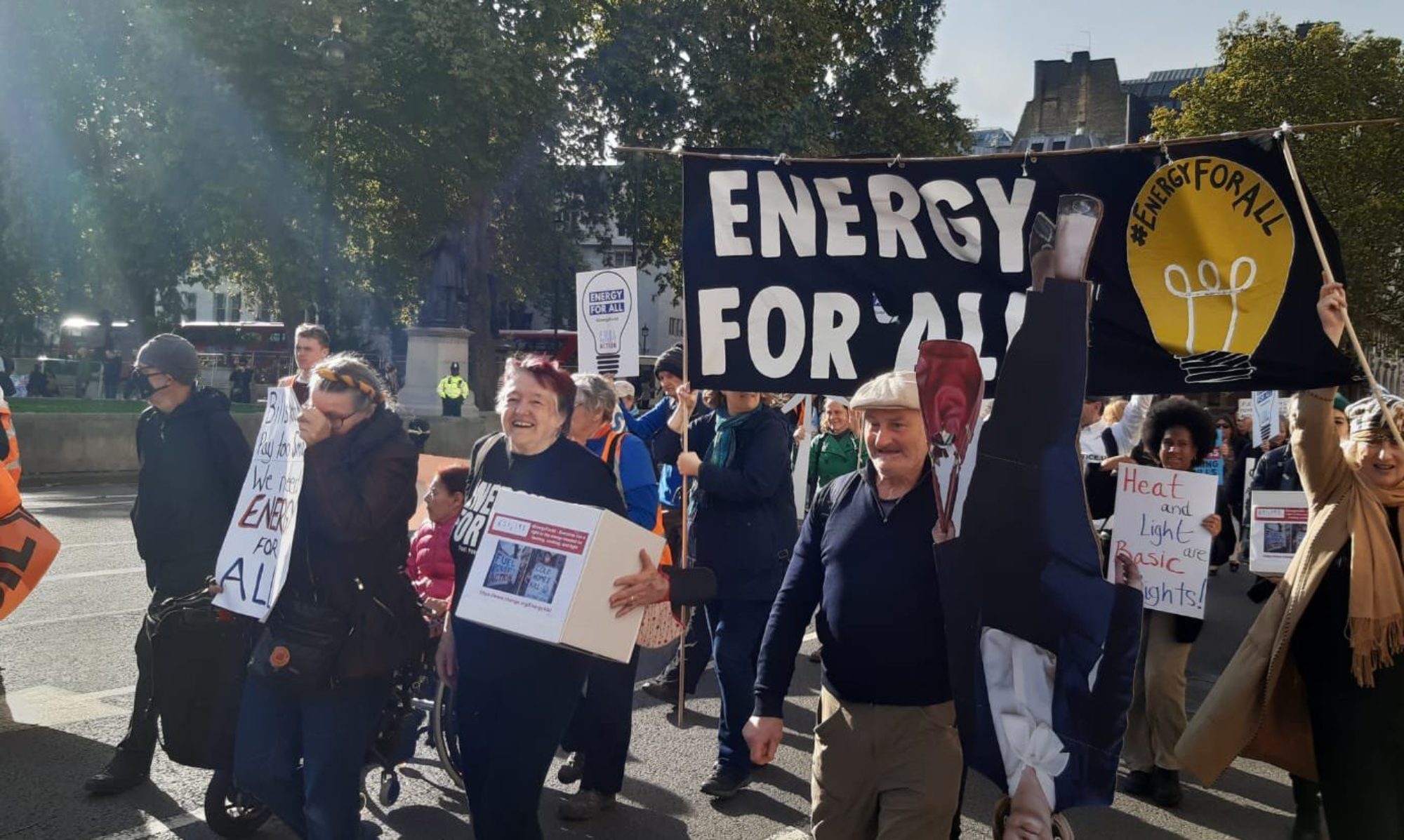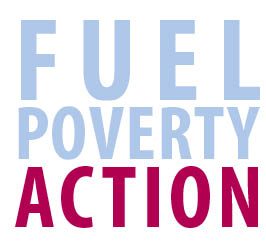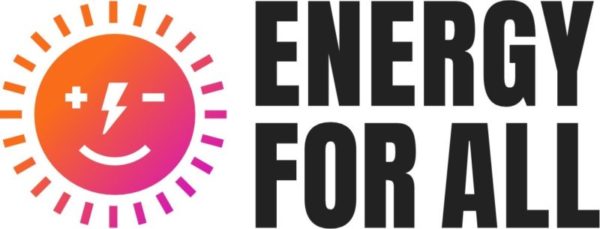This winter, Fuel Poverty Action are coordinating nationwide protests demanding an end to fuel poverty. Join us in taking action, check out our map of upcoming Warm Ups.
Warm Ups have been used successfully by Fuel Poverty Action (FPA) to highlight fuel poverty and bring about change. They are based on the principle that if we can’t afford to heat our own homes, we have a right to go into any public space and keep warm there – and talk to passers-by, hold a speak-out, or a discussion, or a party! In the past, FPA and allies have warmed up in public buildings including for example Brixton Library with tenants from a local council estate and Lambeth Pensioners Action Group and in a bank, shopping centres, a concert venue, and even the House of Commons lobby!
In winter 2022-3 there were Warm Ups in towns and cities around the UK, organised in collaboration with Don’t Pay and other groups.
Security guards at the location often do not want to remove people. During one Warm Up in Stratford Westfield the security guards refused to kick people out of the building, many of whom were elderly. Depending on where you go, it could be worth thinking about how best to make an appeal to the people who work there.
Since the launch of the Energy For All Campaign, two national days of Warm Ups have taken place on December 3rd 2022 and January 21st 2023. The January date helped to deliver a temporary moratorium on the forced installation of prepayment meters.
Below is a guide on how you can organise a Warm-Up in your area.
STAGE 1 CO-ORDINATING
Forming a Coordinating Team
The coordinating team will make sure that all of the below happens. This is ideally one or two people only, who keep track of everything – this doesn’t mean they have to do all the work themselves!
The first step in forming the coordinating team is contacting the members of your local WhatsApp group. In a very large WhatsApp group, you may be able to simply leave a message in the chat and get a response. However sometimes single posts may go unnoticed, a good idea can also be to try messaging people individually. Remember in this early stage you only need 1 or 2 people to collaborate with you. We will look at forming a bigger group later.
Arranging first meeting
The next step is to meet with the coordinating team. This can be either in person, on zoom or via a phone call. The important thing is to keep it simple – people have different levels of availability so it may be unrealistic to find a time when everyone can meet.
Agenda for the first meeting
At this first meeting, you will need to pin down two things.
- a) potential location for the action
- b) who to invite to take part
It is a good idea to have these pinned down as early as possible, as making decisions like these in larger meetings can be difficult.
STAGE 2 PLANNING
Picking a location
When picking a location there are a few things to consider. Picking a location should take into account the wishes of the groups you want to involve.
Lower Risk. These are public locations that you have a right to congregate in but you may be asked to leave:
– Libraries
– Shopping Centres
Medium Risk. These are private locations you are allowed to enter but will likely be asked to leave by the staff on some occasions security could be called:
– Lobby/foyer of local council building
– Lobby of a bank
– And plenty more options…
Places to avoid
– Hospital medical facilities
– Childcare facilities
– Places that shelter vulnerable people
– Religious centres
Remember that both security guards and police can be unpredictable and will sometimes act beyond their powers. New policing powers in England and Wales have also severely restricted protest rights.
Find information and Know Your Rights trainings, or request legal observers for your Warm Up at:
England & Wales – https://greenandblackcross.org/guides/.
Scotland – https://www.scottishactivistlegalproject.co.uk/.
Inviting people to participate
- a) Members of your local WhatsApp group(s).
Once your coordinating team has met and agreed some basics, you can go back to local group chats with a proposal, inviting people to get involved in the build up or on the day. If you don’t get many responses in the group, you may want to message people individually.
- b) Local Community Groups
The next step should involve inviting other groups into the area. Think about what groups are local to you and how they may be affected by rising bills
– Local charities
– Pensioners associations
– Faith groups
– Climate activist groups
– Local people through street canvassing, visiting warm hubs or food banks.
- c) Trade Unions
Many Trade unions have spoken out publicly about energy prices. If you are a member of a union contact your union branch and invite them along. Your town may also have a Trades Council where local union reps meet and discuss supporting activities like this. Not all Trades Councils have a large web presence. The easiest way to find a trades council is by searching “The name of your town” Followed by “Trades Council” in google.
Briefing
Ideally, this should happen a few days before the action. You may not be able to get everyone to attend but you need to have enough people come along to ensure people have been assigned roles and the action is carried out safely.
Briefing should cover
– Introductions
– Why we are here
– Safety points fire exits
– Assigning roles
– De-escalating
Assign roles
Spokesperson, This person is responsible for explaining why the action is happening. They could be talking to the local press, on a livestream, or to the people responsible for the building you are keeping warm in.
De-mobiliser This person is responsible for ensuring the action ends safely. You will need to discuss in your groups how long you wish to stay in the building. When the De-mobiliser tells people to leave the action is over. Anyone who stays after this does so on their own accord.
Documenter Responsible for filming and taking pictures
Leafleter/s Handing out flyers, if you have any, explaining why you are there or what you think should be done. This can also be a good way to chat to people passing by.
STAGE 3 ON THE DAY
Press Release
Use and amend our Template Press Release to send to local media outlets. Make sure to contact [email protected] to inform us that your action is taking place.
This can be edited to fit the details of your local action and should be sent to local news outlets the night before as well as just after the action.
Be sure to include.
- Pictures from the action (or a link to where pictures will be uploaded)
- Quote(s) from participants.
Bring signs and banners
Make sure your action is visible and creative. Could everyone wear warm coats and bring a thermos flask? Or a hot water bottle?
Think about what messages you want to get across. Examples include:
“Energy For All”
“Ban forced Prepayment Meters”
“Cold homes kill”
“Disconnections are Deadly”
“Freeze profits, not people”
“Energy is a human right”
Think of how to stay busy and entertained
You might want to bring instruments
Books
Arts and crafts
Cards or board games
Holding group discussions or speak outs
Singing, chanting or dancing
Deciding how long to stay
You should think about this in advance, and take into account the preferences of people taking part.
For example, the group could just go in for a photo op, stay until asked to leave by security, or push it further than that and refuse to leave.
Of course, the number of people who turn up may change how long you want to stay at your location – bigger numbers make you harder to remove!
Remember you are part of a larger national day of action and all contributions are valuable in getting the message out
Make a video and take photos
Make a short video explaining who you are and why you are doing this. Be sure to take lots of pictures.
Collect emails, take contact details
Be sure to tell people passing by why you are doing what you are doing. Ask people to provide email addresses and phone numbers so they can support future actions.
Share!
Be sure to share evidence of the action happening so everyone can see how far and wide the action is across the UK – Use our Social Media Toolkit for suggestions on what to post
- On any social media accounts you have access to, tag FPA @FuelPovAction or @fuelpovertyaction
- In WhatsApp chats


